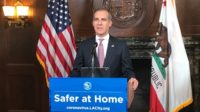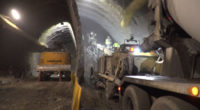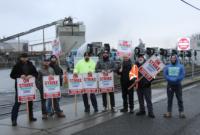Washington state's Sound Transit has temporarily suspended 80% of its capital construction to reduce COVID-19 transmission after reporting an inability to meet safety guidelines and insufficient staffing.
“Through our collaboration with contractors, other industry partners and labor, we have learned that our contractors are experiencing 25% to 30% absenteeism among labor,” said Ron Lewis, Sound Transit executive director of design, engineering and construction management, in a memo to staff that was provided to ENR. “A number of smaller subcontractors have been unable to perform at all, due to high absenteeism, and many have reported high anxiety among the workforce.”
The April 6 memo also cites materials plant closures, limited capacity delaying concrete delivery and contractors reporting problems implementing social distancing guidelines as factors for the halt.
Some work will continue on projects including: Hilltop Tacoma Link, Federal Way Link Extension (F200 Design Build Project), Lynnwood Link Extension, Northgate Link Extension, Operations and Maintenance Facility – East (OMF-E) (M200), East Link Extension, Downtown Redmond Link Extension, Puyallup Parking Garage (Sounder), and LRV Fleet Expansion Project.
Mark Riker, executive secretary of the Washington State Building and Construction Trades Council, says the region’s supply chain is not currently able to provide enough personal protective equipment (PPE) for both health care and construction workers.
Industry workers will return to jobsites when proper enhanced safety measures are available and in place. Up to 70% of council members are specifically affected by the Sound Transit halt, says Riker.
“With so many unknowns, many members have legitimate concerns about the consequences of what used to be normal behavior,” he adds.
The Associated General Contractors of Washington says Sound Transit’s halt impacts a high percentage of its contractors, who also report a significant rate of absenteeism.
“I think we are in a unique place in that the goal here really is to bring workers back safely to jobsites and there is an effort between business, labor and public agencies at a very high level with everyone working together with the same goal in mind,” says David D’Hondt, AGC of Washington executive vice president.
Both AGC of Washington and state building trades report participating on April 7 in the first bi-weekly scheduled meeting with representatives of Washington Gov. Jay Inslee and others in industry to develop new safety and health requirements.
The meetings are roundtable conversations with construction workers and contractors to clarify safety and health expectations for essential projects still underway, says Mike Faulk, spokesperson for the governor. “Ultimately, our goal is to prepare an appropriate return-to-work strategy for the rest of the industry,” Faulk says. “That strategy will be informed by workers, contractors, health and safety experts, and local government, for how construction can safely resume."
There is currently no timeline for when non-essential construction will restart, Faulk says.
The Washington State Dept. of Transportation also said April 6 that despite working on COVID-19 response plans with contractors, labor and other industry partners, it could not meet Centers for Disease Control and Prevention guidelines to maintain construction, in part stemming from low staffing.
“In some cases, this week, between 25% and 40% of a given crew was not available to work on [agency] construction projects,” says a state DOT update. In March, it halted all active construction projects, a total of 92, except for fish passage projects, until May 4.





Post a comment to this article
Report Abusive Comment